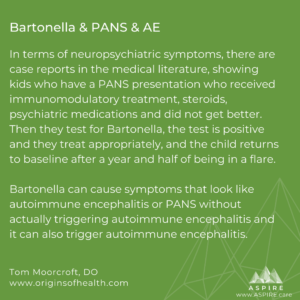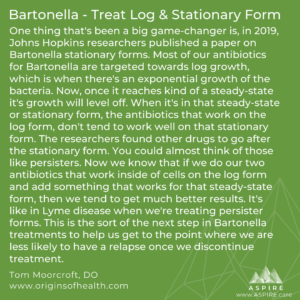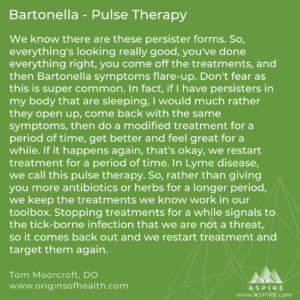Section 4: Bartonella & Babesia
ASPIRE talks with Tom Moorcroft, DO about some of the most frequently asked questions on Lyme disease and tick-borne illness including Bartonella and Babesia. This article is divided into 4 separate sections.
- Section 4: Bartonella & Babesia Co-Infections
Bartonella & Babesia Co-Infections
What is the Connection Between Bartonella and PANS?
 There’s a lot of patients in the PAN’s community who are being treated for Bartonella. There are a lot of different species; the ones we most commonly know are Bartonella henselae, Bartonella quintana and Bartonella bacilliformis. Bacilliformis really isn’t in the United States despite one lab is telling us differently. This may change in the future as we have more rigorous scientific research. Bartonella quintana, which is known as the causative agent of trench fever, can be transmitted by fleas and lice.
There’s a lot of patients in the PAN’s community who are being treated for Bartonella. There are a lot of different species; the ones we most commonly know are Bartonella henselae, Bartonella quintana and Bartonella bacilliformis. Bacilliformis really isn’t in the United States despite one lab is telling us differently. This may change in the future as we have more rigorous scientific research. Bartonella quintana, which is known as the causative agent of trench fever, can be transmitted by fleas and lice.
Bartonella henselae is known as the causative agent of cat scratch disease, and it can cause very mild symptoms to some pretty serious, severe symptoms including swallowing lymph nodes, retinitis, neuropsychiatric symptoms and endocarditis. Bartonella henselae has found in spiders. There’s a question of whether or not we see it in deer ticks and if it can be transmitted by them. Labwork done in Europe showed that a tick could give Bartonella henselae to a mouse. Also, in Europe, 70% of their Ixodes tick, similar to our deer tick, may be infected with Bartonella. In the US, we have some studies that 33% of ticks have Bartonella; in that same study, the same percent of ticks had Borellia too. But, other, more recent studies have not shown any Bartonella henselae in ticks.
I have a lot of people who have Lyme disease and other tick-borne co-infections, who also have concurrent Bartonella, whether or not the Bartonella from a tick. Bartonella is in our environment, our kids and adults have it, and it’s leading to significant symptoms.
I often find positive Bartonella tests in a pediatric patient who is having PANS symptoms. Then, for example, we talk to the teacher who says three kids had neuropsychiatric behavioral issues or acute onset ADHD crop up right after a lice outbreak.
We also know that the Bartonella henselae and quintana antibodies cross-react. This means the henselae caused quintana to be positive, and vice versa. So if Bartonella pops up, I think about what’s going on and what species it really is. I can’t always know definitively. The treatments are the same, and they’re effective.
In terms of neuropsychiatric symptoms, there are case reports in the medical literature, showing kids who have a PANS presentation who received immunomodulatory treatment, steroids, psychiatric medications and did not get better. Then they test for Bartonella, the test is positive and they treat appropriately, and the child returns to baseline after a year and half of being in a flare.
Bartonella can cause symptoms that look like autoimmune encephalitis or PANS without actually triggering autoimmune encephalitis and it can also trigger autoimmune encephalitis.
Generally speaking, one way we figure this out is by treating the Bartonella. If the symptoms get under control quickly without having to do a lot of immune modulation, then we might just be dealing with Bartonella, and not Bartonella and PANS.
Now, in the long run, whether it’s just Bartonella, or Bartonella induced PANS or PANS triggered by other assaults, most of our treatments are a little longer term. It is when there is a quick turnaround that really seems to clue us in. It’s similar to when you have acute strep plus PANDAS, then you do the treatment immediately, and the kids get better right away. With Bartonella, if the diagnosis is prolonged, I wouldn’t expect such a rapid turnaround, unless the PANS is triggered by Bartonella.
Is One More Likely to Develop PANS from Bartonella if One is Immune compromised?
Generally speaking, not really. Most of my kids who get Bartonella induced PANS or PANS whose immune systems are working just fine. And then they get this infection that triggers a hyperactive immune response. We have to remember PANS is a hyperactive immune response, whereas immunocompromised means it’s low.
An immune-compromised individual can also get a hyper-reactive response to an infection like when Bartonella triggers PANS. This might be a person where intravenous gamma globulin (IVIG) makes a bit more sense as giving them the immunoglobulin might be something they need. But you can often get this done without IVIG but with the help of diet, supplements, low dose naltrexone, and even peptides like Thymosin alpha 1.
Does Bartonella Cause Tracks/Stretch Marks?
Tracks used to be called violateous striae, stretch marks or Striae atrophicae; now, we’re calling them tracks.
Bartonella, in immunocompromised people, is known to trigger new blood vessels to grow from pre-existing ones. There’s a theory that Bartonella can trigger growth of new blood vessels into stretch marks (or even cause the stretch marks) making them red or purplish. There are two studies that have tried to find Bartonella in the stretch marks. One study showed something that looked liked Bartonella, but when they tested its DNA, it was not. In another study, they found evidence of Bartonella, but that doesn’t mean the stretch mark was definitively caused by Bartonella.
The stretch marks/tracks many people feel are associated with Bartonella are typically not in skin planes. With that said, someone can get a regular stretch mark in skin planes from becoming overweight or a growth spurt. Then subsequently, the person gets Bartonella, and then Bartonella may cause the growth of blood vessels into those pre-existing stretch marks.
Are the Bartonella Stretch Marks/Tracks Blanchable?
If the theory behind Bartonella vaso-proliferation or that growth of new blood vessels is true, then we should be able to push on the stretch mark/track and have the blood go out and come back in. Most stretch marks caused by weight gain do not change when pressed on. In my practice, I have seen part of it won’t blanch, but another part of the track will blanch, often at the tips. Then when I treat that person, the tips get better, and the rest of the stretch mark remains the same. So, it is possible that we have both phenomena going on in a single stretch mark.
How to Treat Bartonella? Is it Curable?
If you look at the literature on Bartonella, it shows that a single antibiotic like azithromycin, which is the drug of choice for cat scratch disease, isn’t effective. In a petri dish, within a couple of generations, it will become resistant to that drug. We really need two or three drugs in combination to go after it. We can also do antibiotics in combination with herbs. A lot of our herbal formulations really work well for Bartonella.
One thing that’s been a big game-changer is, in 2019, Johns Hopkins researchers published a paper on Bartonella stationary forms. Most of our antibiotics for Bartonella are targeted towards log growth, which is when there’s an exponential growth of the bacteria. Now, once it reaches kind of a steady-state it’s growth will level off. When it’s in that steady-state or stationary form, the antibiotics that work on the log form, don’t tend to work well on that stationary form. The researchers found other drugs to go after the stationary form. You could almost think of those like persisters. Now we know that if we do our two antibiotics that work inside of cells on the log form and add something that works for that steady-state form, then we tend to get much better results. It’s like in Lyme disease when we’re treating persister forms. This is the sort of the next step in Bartonella treatments to help us get to the point where we are less likely to have a relapse once we discontinue treatment.
I think people can be cured, just like Lyme disease and any other infection. It’s a matter of getting the right treatments, treating the actively reproducing forms and the stationary or persister forms, and making all the lifestyle choice changes that give you the best chance of being cured.
We know there are these persister forms. So, everything’s looking really good, you’ve done everything right, you come off the treatments, and then Bartonella symptoms flare-up. Don’t fear as this is super common. In fact, if I have persisters in my body that are sleeping, I would much rather they open up, come back with the same symptoms, then do a modified treatment for a period of time, get better and feel great for a while. If it happens again, that’s okay, we restart treatment for a period of time. In Lyme disease, we call this pulse therapy. So, rather than giving you more antibiotics or herbs for a longer period, we keep the treatments we know work in our toolbox. Stopping treatments for a while signals to the tick-borne infection that we are not a threat, so it comes back out and we restart treatment and target them again.
The good news is Lyme disease and Bartonella are relatively slow reproducing. You’d have to not treat yourself four to six months or probably even longer to get to the point where the infection is in a severe state. In between treatments, you may see more symptoms because your tissue hasn’t healed, and your body has a memory of that. It is important to understand that your symptoms may not tell you how much bacterial load you have in your body. These are slow reproducing organisms. Thus, coming off treatment for a period of time, and then flaring doesn’t necessarily mean you’re worse (meaning getting a higher bacterial load). It just means that it came back, and it’s time to take a little more action.
Why Do You Think Bartonella is Not Found in Ticks Tested by Tick Report at U MASS Amherst?
I use Dr. Steven Rich’s lab quite a bit because they have a quick turnaround to find what’s in the tick bit you. You put it in the mail, a couple of days later you have results, and they seem pretty accurate. Bartonella, in the United States, is seen variably in ticks. I’ve seen a bunch of recent research that hasn’t found it, but research from the mid-2000s did actually see it. I see Bartonella very commonly, and whether it’s from a cat scratch, cat bite, a spider bite, lice, or tick bit, it doesn’t matter. I’m getting positive tests, and their symptoms look like Bartonella and the treatments for work. See Article: Lyme – Tick Testing – Dr. Rich
Tokarz, in a recent study, did not find Bartonella in ticks in Connecticut and New York. UMass Amherst is not finding it in ticks either. One of the original studies from 2004 was done in New Jersey; maybe it’s time to redo that test. But my recommendation for patients and clinicians is to let the researchers do that work; if our best researchers say Bartonella is not in ticks in the United States, great. But it’s still in our patients. There are other vectors of Bartonella that are probably much more common than a tick.
Ultimately, we’re seeing that when people present clinically with symptoms that look like Bartonella and we treat them, they’re getting better. And we also see, with effective treatments, that the titers go down and people are better. That’s the most important thing.
Does Babesia Trigger PANS?
I don’t really see research linking the Babesia to PANS. However, PANS is an infection triggered autoimmune encephalitis, and, at one point in time, we had no research showing that Bartonella triggered PANS. But now we do because people studied it and found it is a PANS trigger.
It is very common that people with Lyme and Bartonella also have Babesia. I’ve seen children with PANS, who have Lyme and Babesia but don’t have Bartonella. The problem is, in most of our Lyme studies, between 35-70%, in some studies, 90% of the deer ticks have Lyme, and 8-10% have concurrent Babesia.
Part of the issue with answering the question is that most of those who have the Babesia also have Lyme disease So, is it a concurrent sort of trigger or could Babesia trigger PANS by itself, we just don’t know at this time. Clinically, it looks like it might. But, I can’t remember the last time I saw somebody with the Babesia and no other tick-borne co-infection. What I do know is that if you have the Babesia and concurrent PANS symptoms, I need to treat whatever I think the underlying cause of the PANS is, as well as treat the Babesia.
When I treat Babesia, it is easier to treat the PANS. Either that’s because I’ve unburdened the immune system from a second infection and, now, the immune system can focus on that primary infection or because the Babesia was triggering the PANS itself. Working on those issues concurrently is important.
In Babesia, there are a lot of summer flu symptoms just like Lyme disease, but there are also symptoms of brain fog, headaches, (particularly described as head pressure like a tight band is around the head), and bone and rib pain, presumably because the Babesia is a red blood cell parasite. Red blood cells are made in the bone marrow, so this might be one reason we see this bone pain. We see a lot of dysautonomia, dysregulation of our automatic processes in the body. This is where POTS comes in, with the inability to regulate heart rate and blood pressure. Heart palpitations, dizziness, air hunger are often reported. Digestion can be off.
This begins to sound a lot like some of the things that happen in PANS, again, is it a direct correlation or layered symptoms? I try to prioritize treatment; do symptoms look more like Babesia, Bartonella, or PANS and then treat what is making the most significant impact, which helps get through treatment faster.
See more on Bartonella: Lyme Co-Infections Overview & Lyme Disease and Herbal Treatments – Dr. Wells


Section Links to Overview of Lyme & Tick-Borne Illness – Dr. Moorcroft
- Section 1: Lyme Disease and Tick-Borne Illness Overview
- Section 2: Treatment for Lyme Disease
- Section 3: PANS & Lyme Disease
- Section 4: Bartonella & Babesia Co-Infections
2 comments to Bartonella & Babesia – Dr. Moorcroft
Deb Salmon
March 29, 2021Please recommend a physician who is up to date knowledgeable on Bartonella treatment. 30 years sick. Many Doctors .Never a thorough treatment with cure. Thank you. Deb Salmon 731-616-9293 or dksalmon@gmail
Gabriella True
April 1, 2021We have a provider list – http://aspire.care/treating-pans/find-a-provider/ and you can sort by LLMD – https://www.ilads.org/. Or you can go on the Ilads website for more recommendations. There is a Bartonella Facebook page – Beating Bartonella that is informative.